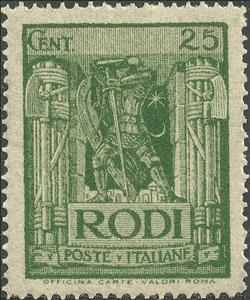Stamp: Views- Christian knight (Aegean Islands 1938)
Views- Christian knight (Aegean Islands 1938)
01 January (Aegean Islands ) within release Visit of King of Italy goes into circulation Stamp Views- Christian knight face value 25 Italian centesimo
| Stamp Views- Christian knight in catalogues | |
|---|---|
| Sassone: | Sas: IT-EG 59/I |
| Unificato: | Un: IT-EG 59A |
| Karamitsos: | Kar: IT-EG 102A |
Stamp is vertical format.
Issued in 1938-39.Watermark vertical crown sideways left/right. 50 stamps sheets.Also in the issue Visit of King of Italy:
- Stamp - Views- Christian knight face value 25;
- Stamp - Views- Crusader's tomb face value 1.25;
- Stamp - Views- Medieval Galley face value 10;
- Stamp - Views- Windmill face value 5;
Stamp Views- Christian knight it reflects the thematic directions:
The Moon is Earth's only natural satellite. It orbits at an average distance of 384,400 km (238,900 mi), about 30 times the diameter of Earth. Tidal forces between Earth and the Moon have over time synchronized the Moon's orbital period (lunar month) with its rotation period (lunar day) at 29.5 Earth days, causing the same side of the Moon to always face Earth. The Moon's gravitational pull – and to a lesser extent, the Sun's – are the main drivers of Earth's tides.
A star is a luminous spheroid of plasma held together by self-gravity. The nearest star to Earth is the Sun. Many other stars are visible to the naked eye at night; their immense distances from Earth make them appear as fixed points of light. The most prominent stars have been categorised into constellations and asterisms, and many of the brightest stars have proper names. Astronomers have assembled star catalogues that identify the known stars and provide standardized stellar designations. The observable universe contains an estimated 1022 to 1024 stars. Only about 4,000 of these stars are visible to the naked eye—all within the Milky Way galaxy.


